Leading Change: Drivers, Strategies, and Organizational Response
VerifiedAdded on 2023/01/06
|12
|3352
|25
Report
AI Summary
This report delves into the complexities of leading change within organizations, utilizing Marks & Spencer and Tesco as case studies. It begins with an introduction to the concept of leading change, emphasizing the distinction between planned and unplanned changes and their impact on organizational strategies and operations. The report then analyzes the internal and external drivers of change, such as legal factors, market dynamics, and technological advancements, and their effects on the structure, strategy, and operations of the chosen companies. It examines the impact of these drivers, offering a comparison of how Marks & Spencer, Tesco, and House of Fraser have adapted. Furthermore, the report evaluates the measures taken to mitigate the negative effects of change on organizational behavior, including leadership styles and cultural adjustments. Finally, it applies theoretical frameworks such as Systems Theory and the Burke Litwin Model to critically assess the responses of Marks & Spencer and Tesco to change, offering insights into effective change management strategies.
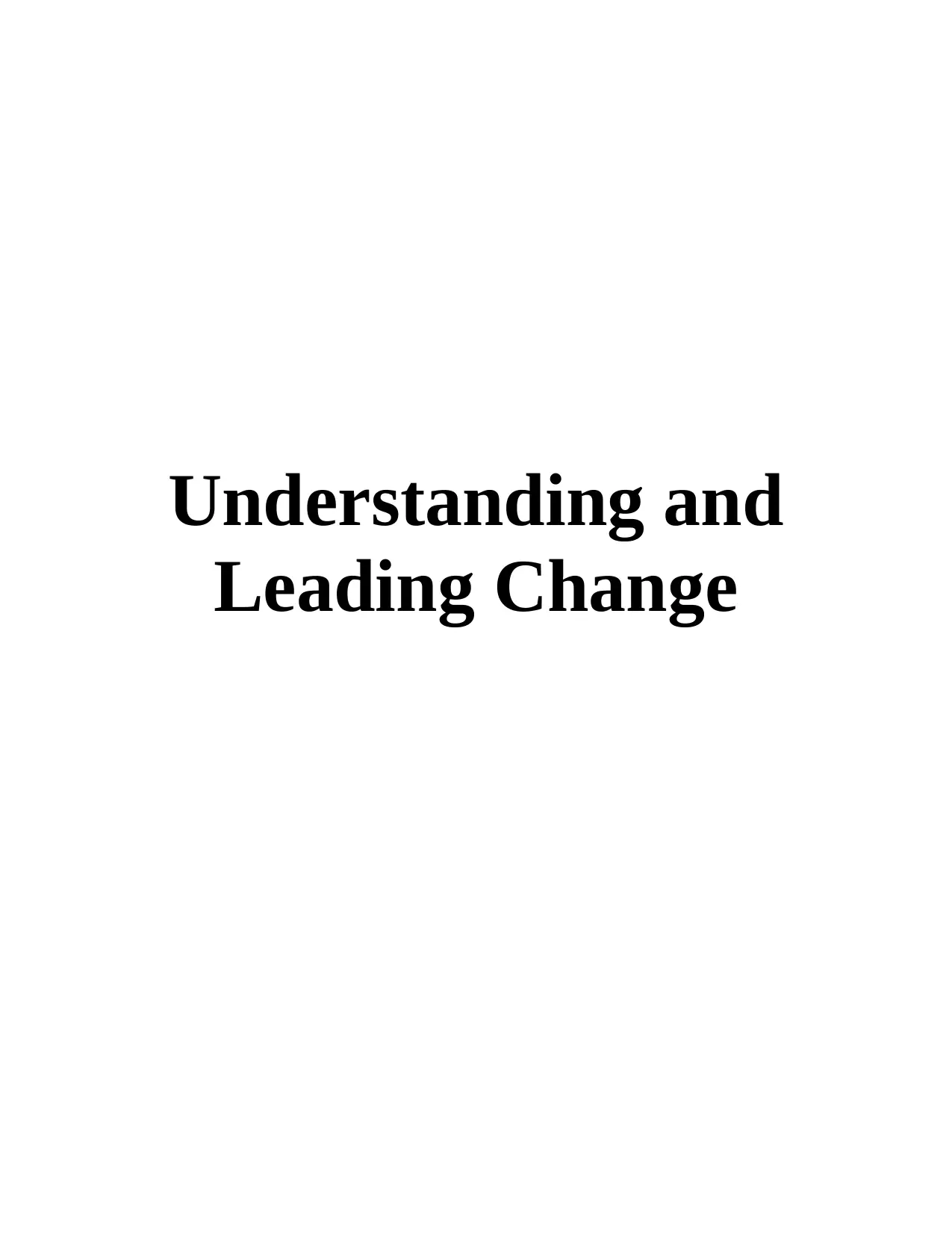
Understanding and
Leading Change
Leading Change
Paraphrase This Document
Need a fresh take? Get an instant paraphrase of this document with our AI Paraphraser
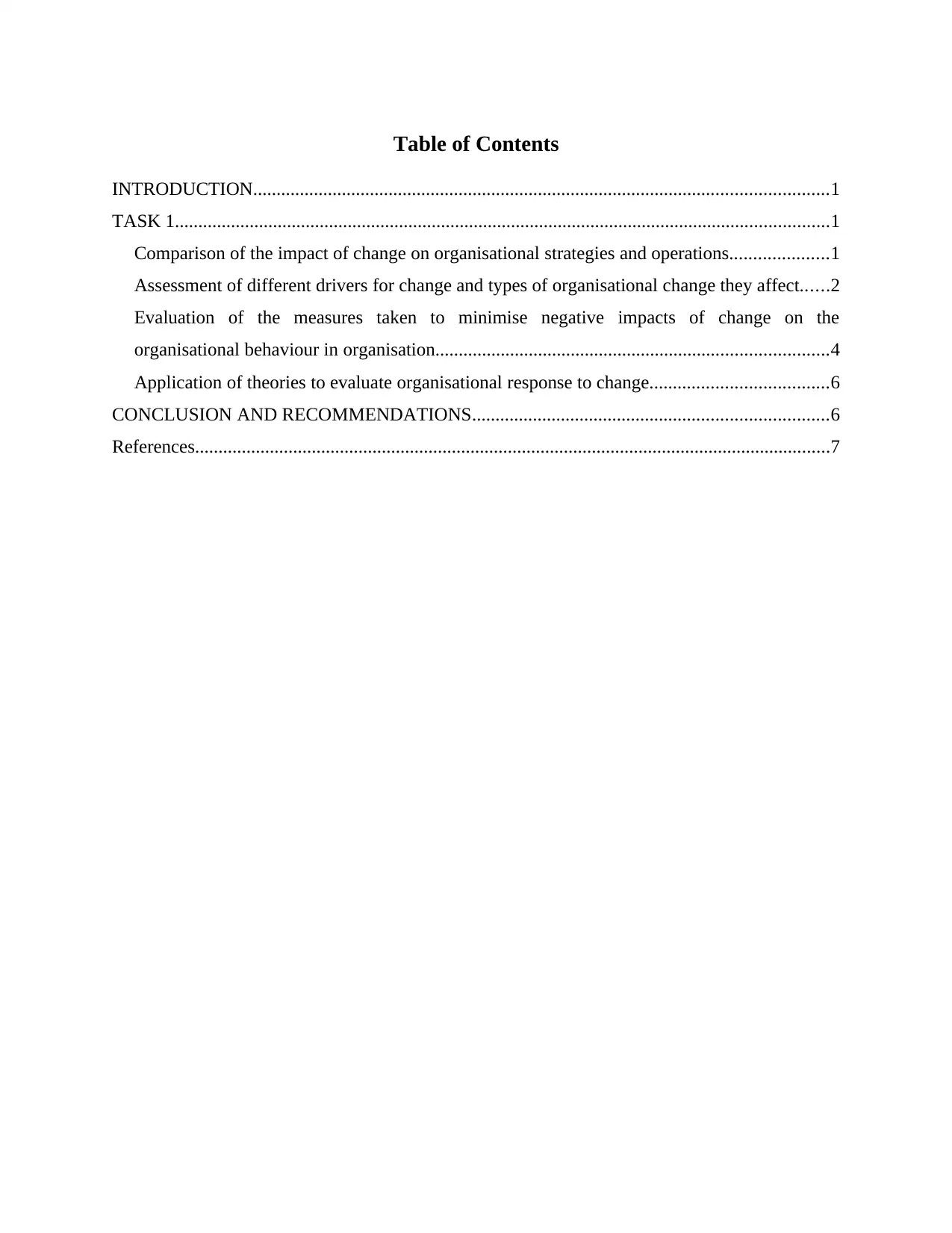
Table of Contents
INTRODUCTION...........................................................................................................................1
TASK 1............................................................................................................................................1
Comparison of the impact of change on organisational strategies and operations.....................1
Assessment of different drivers for change and types of organisational change they affect......2
Evaluation of the measures taken to minimise negative impacts of change on the
organisational behaviour in organisation....................................................................................4
Application of theories to evaluate organisational response to change......................................6
CONCLUSION AND RECOMMENDATIONS............................................................................6
References........................................................................................................................................7
INTRODUCTION...........................................................................................................................1
TASK 1............................................................................................................................................1
Comparison of the impact of change on organisational strategies and operations.....................1
Assessment of different drivers for change and types of organisational change they affect......2
Evaluation of the measures taken to minimise negative impacts of change on the
organisational behaviour in organisation....................................................................................4
Application of theories to evaluate organisational response to change......................................6
CONCLUSION AND RECOMMENDATIONS............................................................................6
References........................................................................................................................................7
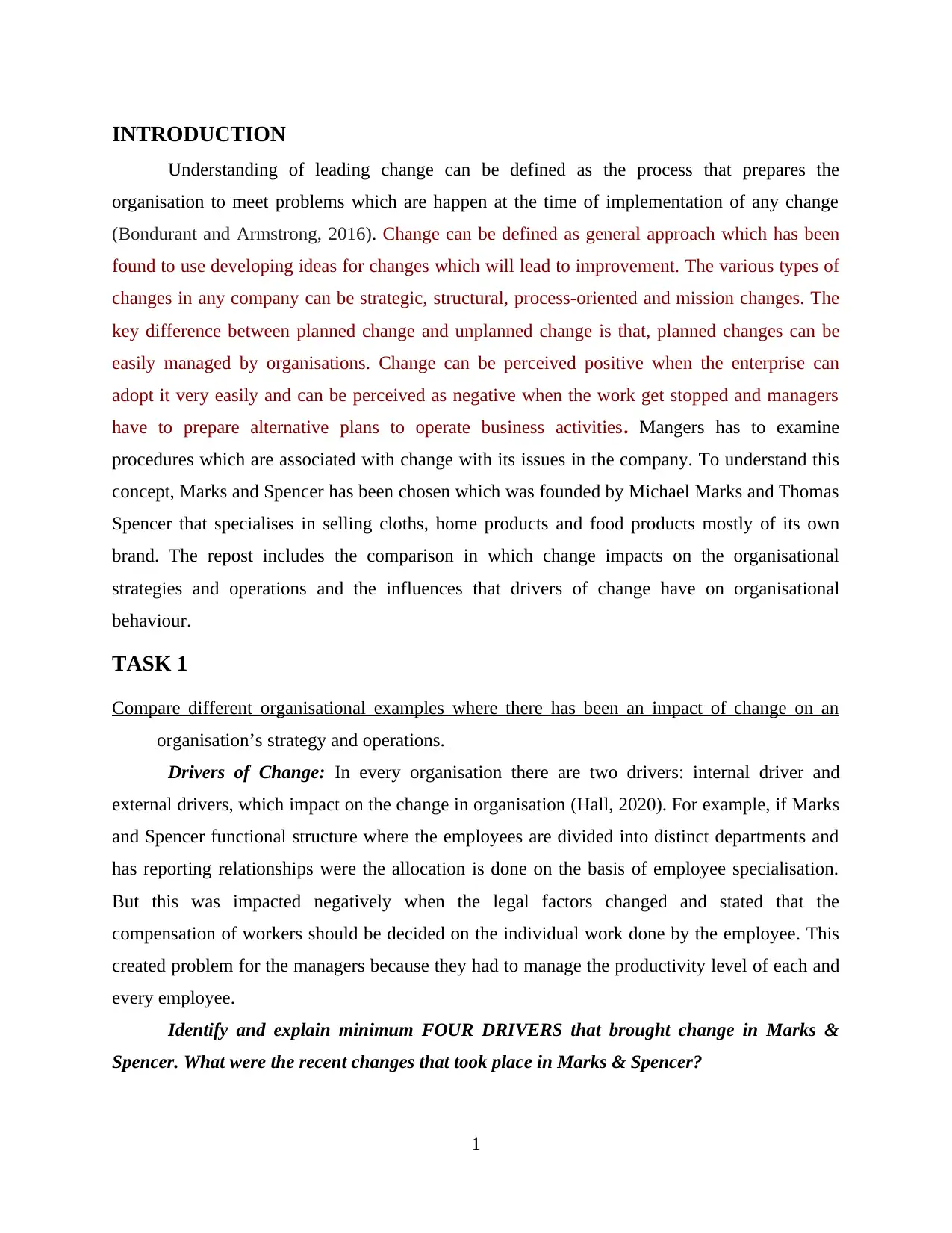
INTRODUCTION
Understanding of leading change can be defined as the process that prepares the
organisation to meet problems which are happen at the time of implementation of any change
(Bondurant and Armstrong, 2016). Change can be defined as general approach which has been
found to use developing ideas for changes which will lead to improvement. The various types of
changes in any company can be strategic, structural, process-oriented and mission changes. The
key difference between planned change and unplanned change is that, planned changes can be
easily managed by organisations. Change can be perceived positive when the enterprise can
adopt it very easily and can be perceived as negative when the work get stopped and managers
have to prepare alternative plans to operate business activities. Mangers has to examine
procedures which are associated with change with its issues in the company. To understand this
concept, Marks and Spencer has been chosen which was founded by Michael Marks and Thomas
Spencer that specialises in selling cloths, home products and food products mostly of its own
brand. The repost includes the comparison in which change impacts on the organisational
strategies and operations and the influences that drivers of change have on organisational
behaviour.
TASK 1
Compare different organisational examples where there has been an impact of change on an
organisation’s strategy and operations.
Drivers of Change: In every organisation there are two drivers: internal driver and
external drivers, which impact on the change in organisation (Hall, 2020). For example, if Marks
and Spencer functional structure where the employees are divided into distinct departments and
has reporting relationships were the allocation is done on the basis of employee specialisation.
But this was impacted negatively when the legal factors changed and stated that the
compensation of workers should be decided on the individual work done by the employee. This
created problem for the managers because they had to manage the productivity level of each and
every employee.
Identify and explain minimum FOUR DRIVERS that brought change in Marks &
Spencer. What were the recent changes that took place in Marks & Spencer?
1
Understanding of leading change can be defined as the process that prepares the
organisation to meet problems which are happen at the time of implementation of any change
(Bondurant and Armstrong, 2016). Change can be defined as general approach which has been
found to use developing ideas for changes which will lead to improvement. The various types of
changes in any company can be strategic, structural, process-oriented and mission changes. The
key difference between planned change and unplanned change is that, planned changes can be
easily managed by organisations. Change can be perceived positive when the enterprise can
adopt it very easily and can be perceived as negative when the work get stopped and managers
have to prepare alternative plans to operate business activities. Mangers has to examine
procedures which are associated with change with its issues in the company. To understand this
concept, Marks and Spencer has been chosen which was founded by Michael Marks and Thomas
Spencer that specialises in selling cloths, home products and food products mostly of its own
brand. The repost includes the comparison in which change impacts on the organisational
strategies and operations and the influences that drivers of change have on organisational
behaviour.
TASK 1
Compare different organisational examples where there has been an impact of change on an
organisation’s strategy and operations.
Drivers of Change: In every organisation there are two drivers: internal driver and
external drivers, which impact on the change in organisation (Hall, 2020). For example, if Marks
and Spencer functional structure where the employees are divided into distinct departments and
has reporting relationships were the allocation is done on the basis of employee specialisation.
But this was impacted negatively when the legal factors changed and stated that the
compensation of workers should be decided on the individual work done by the employee. This
created problem for the managers because they had to manage the productivity level of each and
every employee.
Identify and explain minimum FOUR DRIVERS that brought change in Marks &
Spencer. What were the recent changes that took place in Marks & Spencer?
1
⊘ This is a preview!⊘
Do you want full access?
Subscribe today to unlock all pages.

Trusted by 1+ million students worldwide
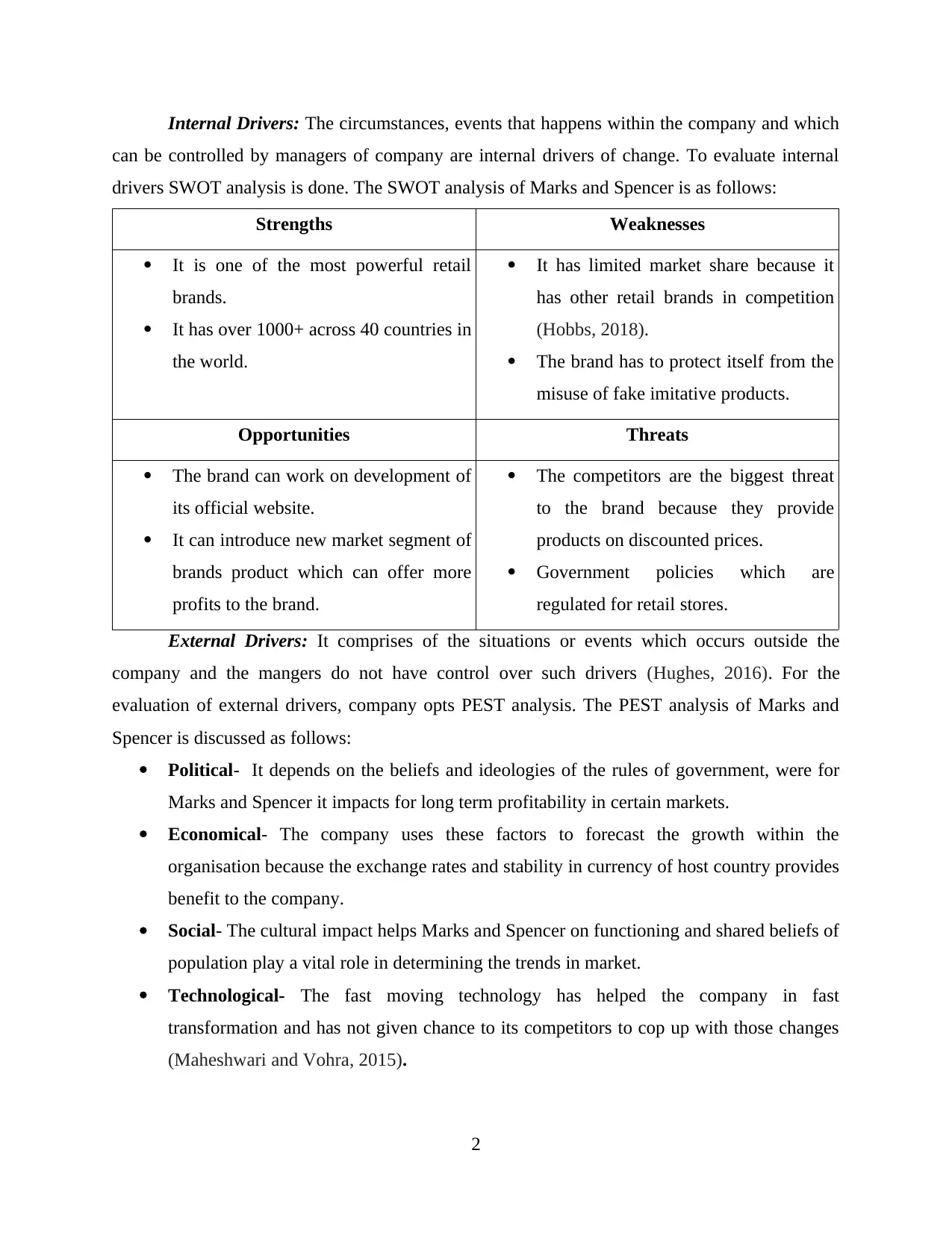
Internal Drivers: The circumstances, events that happens within the company and which
can be controlled by managers of company are internal drivers of change. To evaluate internal
drivers SWOT analysis is done. The SWOT analysis of Marks and Spencer is as follows:
Strengths Weaknesses
It is one of the most powerful retail
brands.
It has over 1000+ across 40 countries in
the world.
It has limited market share because it
has other retail brands in competition
(Hobbs, 2018).
The brand has to protect itself from the
misuse of fake imitative products.
Opportunities Threats
The brand can work on development of
its official website.
It can introduce new market segment of
brands product which can offer more
profits to the brand.
The competitors are the biggest threat
to the brand because they provide
products on discounted prices.
Government policies which are
regulated for retail stores.
External Drivers: It comprises of the situations or events which occurs outside the
company and the mangers do not have control over such drivers (Hughes, 2016). For the
evaluation of external drivers, company opts PEST analysis. The PEST analysis of Marks and
Spencer is discussed as follows:
Political- It depends on the beliefs and ideologies of the rules of government, were for
Marks and Spencer it impacts for long term profitability in certain markets.
Economical- The company uses these factors to forecast the growth within the
organisation because the exchange rates and stability in currency of host country provides
benefit to the company.
Social- The cultural impact helps Marks and Spencer on functioning and shared beliefs of
population play a vital role in determining the trends in market.
Technological- The fast moving technology has helped the company in fast
transformation and has not given chance to its competitors to cop up with those changes
(Maheshwari and Vohra, 2015).
2
can be controlled by managers of company are internal drivers of change. To evaluate internal
drivers SWOT analysis is done. The SWOT analysis of Marks and Spencer is as follows:
Strengths Weaknesses
It is one of the most powerful retail
brands.
It has over 1000+ across 40 countries in
the world.
It has limited market share because it
has other retail brands in competition
(Hobbs, 2018).
The brand has to protect itself from the
misuse of fake imitative products.
Opportunities Threats
The brand can work on development of
its official website.
It can introduce new market segment of
brands product which can offer more
profits to the brand.
The competitors are the biggest threat
to the brand because they provide
products on discounted prices.
Government policies which are
regulated for retail stores.
External Drivers: It comprises of the situations or events which occurs outside the
company and the mangers do not have control over such drivers (Hughes, 2016). For the
evaluation of external drivers, company opts PEST analysis. The PEST analysis of Marks and
Spencer is discussed as follows:
Political- It depends on the beliefs and ideologies of the rules of government, were for
Marks and Spencer it impacts for long term profitability in certain markets.
Economical- The company uses these factors to forecast the growth within the
organisation because the exchange rates and stability in currency of host country provides
benefit to the company.
Social- The cultural impact helps Marks and Spencer on functioning and shared beliefs of
population play a vital role in determining the trends in market.
Technological- The fast moving technology has helped the company in fast
transformation and has not given chance to its competitors to cop up with those changes
(Maheshwari and Vohra, 2015).
2
Paraphrase This Document
Need a fresh take? Get an instant paraphrase of this document with our AI Paraphraser
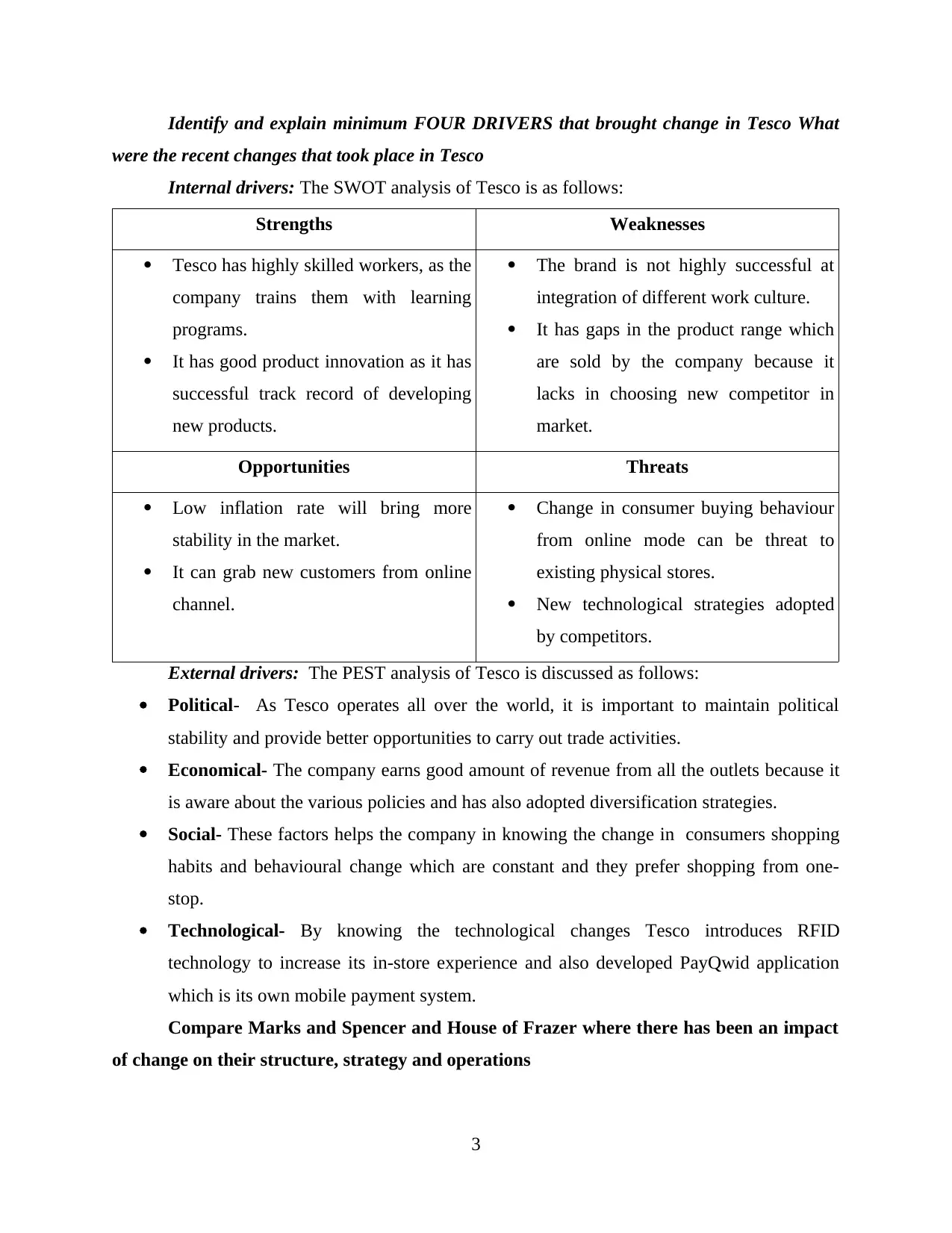
Identify and explain minimum FOUR DRIVERS that brought change in Tesco What
were the recent changes that took place in Tesco
Internal drivers: The SWOT analysis of Tesco is as follows:
Strengths Weaknesses
Tesco has highly skilled workers, as the
company trains them with learning
programs.
It has good product innovation as it has
successful track record of developing
new products.
The brand is not highly successful at
integration of different work culture.
It has gaps in the product range which
are sold by the company because it
lacks in choosing new competitor in
market.
Opportunities Threats
Low inflation rate will bring more
stability in the market.
It can grab new customers from online
channel.
Change in consumer buying behaviour
from online mode can be threat to
existing physical stores.
New technological strategies adopted
by competitors.
External drivers: The PEST analysis of Tesco is discussed as follows:
Political- As Tesco operates all over the world, it is important to maintain political
stability and provide better opportunities to carry out trade activities.
Economical- The company earns good amount of revenue from all the outlets because it
is aware about the various policies and has also adopted diversification strategies.
Social- These factors helps the company in knowing the change in consumers shopping
habits and behavioural change which are constant and they prefer shopping from one-
stop.
Technological- By knowing the technological changes Tesco introduces RFID
technology to increase its in-store experience and also developed PayQwid application
which is its own mobile payment system.
Compare Marks and Spencer and House of Frazer where there has been an impact
of change on their structure, strategy and operations
3
were the recent changes that took place in Tesco
Internal drivers: The SWOT analysis of Tesco is as follows:
Strengths Weaknesses
Tesco has highly skilled workers, as the
company trains them with learning
programs.
It has good product innovation as it has
successful track record of developing
new products.
The brand is not highly successful at
integration of different work culture.
It has gaps in the product range which
are sold by the company because it
lacks in choosing new competitor in
market.
Opportunities Threats
Low inflation rate will bring more
stability in the market.
It can grab new customers from online
channel.
Change in consumer buying behaviour
from online mode can be threat to
existing physical stores.
New technological strategies adopted
by competitors.
External drivers: The PEST analysis of Tesco is discussed as follows:
Political- As Tesco operates all over the world, it is important to maintain political
stability and provide better opportunities to carry out trade activities.
Economical- The company earns good amount of revenue from all the outlets because it
is aware about the various policies and has also adopted diversification strategies.
Social- These factors helps the company in knowing the change in consumers shopping
habits and behavioural change which are constant and they prefer shopping from one-
stop.
Technological- By knowing the technological changes Tesco introduces RFID
technology to increase its in-store experience and also developed PayQwid application
which is its own mobile payment system.
Compare Marks and Spencer and House of Frazer where there has been an impact
of change on their structure, strategy and operations
3
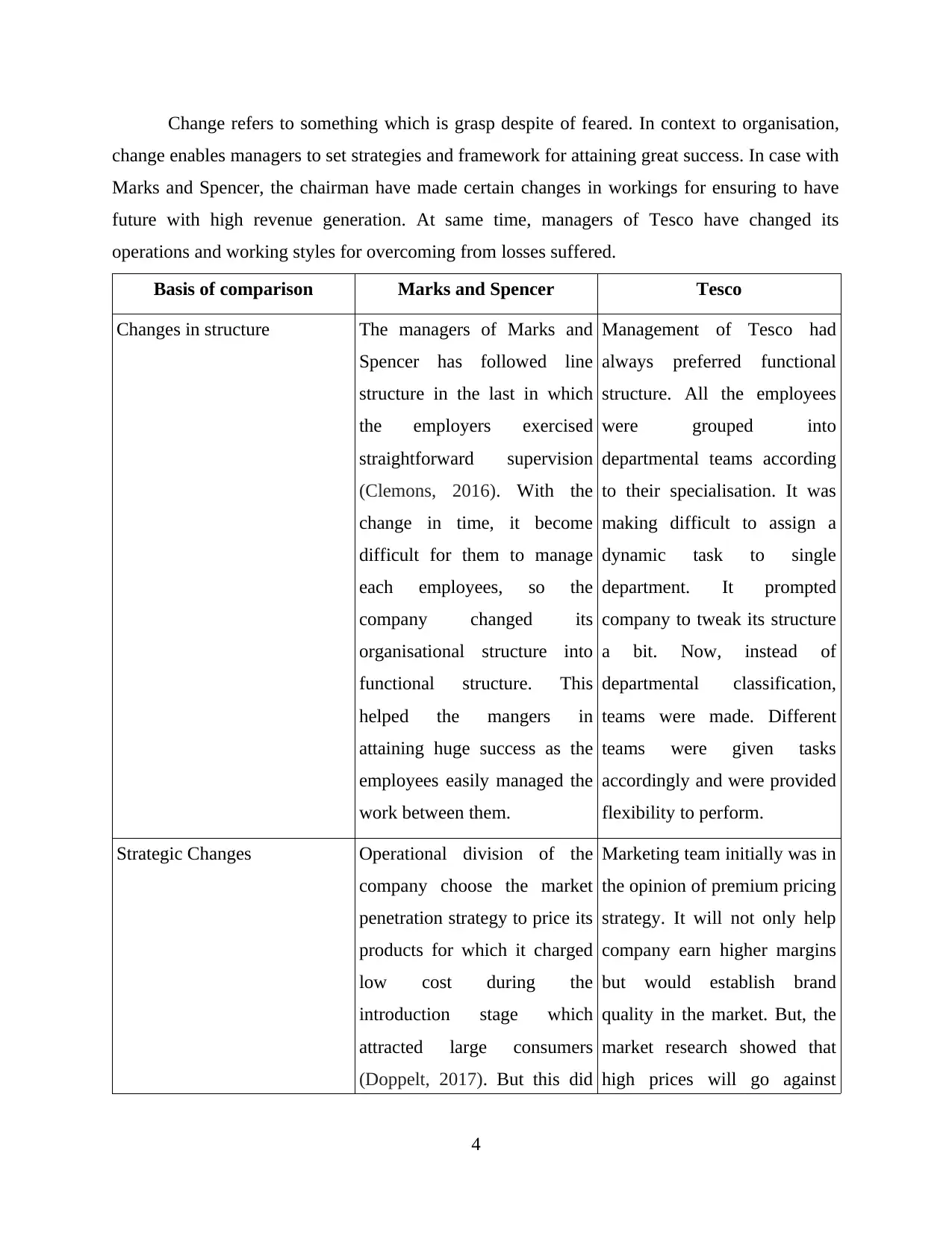
Change refers to something which is grasp despite of feared. In context to organisation,
change enables managers to set strategies and framework for attaining great success. In case with
Marks and Spencer, the chairman have made certain changes in workings for ensuring to have
future with high revenue generation. At same time, managers of Tesco have changed its
operations and working styles for overcoming from losses suffered.
Basis of comparison Marks and Spencer Tesco
Changes in structure The managers of Marks and
Spencer has followed line
structure in the last in which
the employers exercised
straightforward supervision
(Clemons, 2016). With the
change in time, it become
difficult for them to manage
each employees, so the
company changed its
organisational structure into
functional structure. This
helped the mangers in
attaining huge success as the
employees easily managed the
work between them.
Management of Tesco had
always preferred functional
structure. All the employees
were grouped into
departmental teams according
to their specialisation. It was
making difficult to assign a
dynamic task to single
department. It prompted
company to tweak its structure
a bit. Now, instead of
departmental classification,
teams were made. Different
teams were given tasks
accordingly and were provided
flexibility to perform.
Strategic Changes Operational division of the
company choose the market
penetration strategy to price its
products for which it charged
low cost during the
introduction stage which
attracted large consumers
(Doppelt, 2017). But this did
Marketing team initially was in
the opinion of premium pricing
strategy. It will not only help
company earn higher margins
but would establish brand
quality in the market. But, the
market research showed that
high prices will go against
4
change enables managers to set strategies and framework for attaining great success. In case with
Marks and Spencer, the chairman have made certain changes in workings for ensuring to have
future with high revenue generation. At same time, managers of Tesco have changed its
operations and working styles for overcoming from losses suffered.
Basis of comparison Marks and Spencer Tesco
Changes in structure The managers of Marks and
Spencer has followed line
structure in the last in which
the employers exercised
straightforward supervision
(Clemons, 2016). With the
change in time, it become
difficult for them to manage
each employees, so the
company changed its
organisational structure into
functional structure. This
helped the mangers in
attaining huge success as the
employees easily managed the
work between them.
Management of Tesco had
always preferred functional
structure. All the employees
were grouped into
departmental teams according
to their specialisation. It was
making difficult to assign a
dynamic task to single
department. It prompted
company to tweak its structure
a bit. Now, instead of
departmental classification,
teams were made. Different
teams were given tasks
accordingly and were provided
flexibility to perform.
Strategic Changes Operational division of the
company choose the market
penetration strategy to price its
products for which it charged
low cost during the
introduction stage which
attracted large consumers
(Doppelt, 2017). But this did
Marketing team initially was in
the opinion of premium pricing
strategy. It will not only help
company earn higher margins
but would establish brand
quality in the market. But, the
market research showed that
high prices will go against
4
⊘ This is a preview!⊘
Do you want full access?
Subscribe today to unlock all pages.

Trusted by 1+ million students worldwide
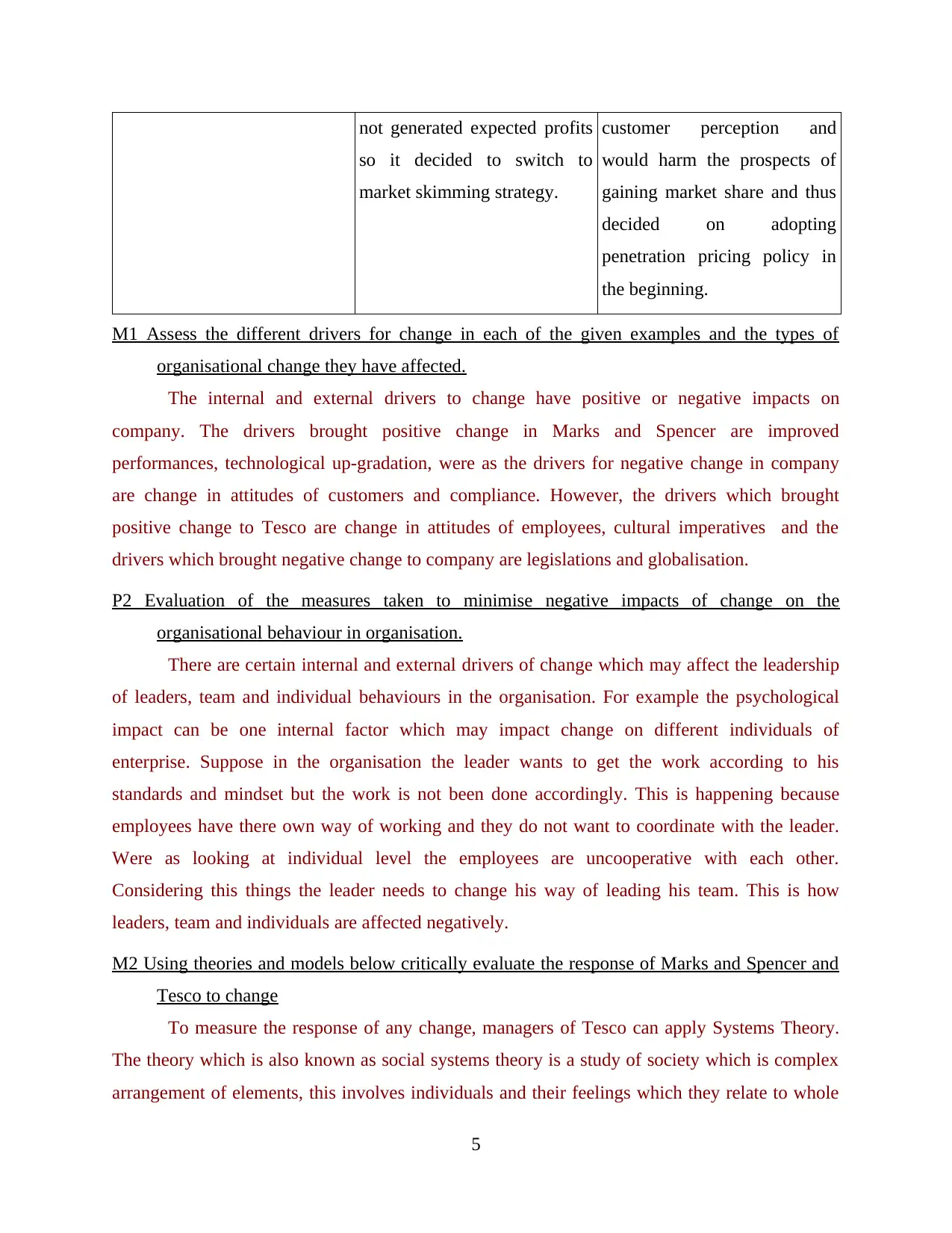
not generated expected profits
so it decided to switch to
market skimming strategy.
customer perception and
would harm the prospects of
gaining market share and thus
decided on adopting
penetration pricing policy in
the beginning.
M1 Assess the different drivers for change in each of the given examples and the types of
organisational change they have affected.
The internal and external drivers to change have positive or negative impacts on
company. The drivers brought positive change in Marks and Spencer are improved
performances, technological up-gradation, were as the drivers for negative change in company
are change in attitudes of customers and compliance. However, the drivers which brought
positive change to Tesco are change in attitudes of employees, cultural imperatives and the
drivers which brought negative change to company are legislations and globalisation.
P2 Evaluation of the measures taken to minimise negative impacts of change on the
organisational behaviour in organisation.
There are certain internal and external drivers of change which may affect the leadership
of leaders, team and individual behaviours in the organisation. For example the psychological
impact can be one internal factor which may impact change on different individuals of
enterprise. Suppose in the organisation the leader wants to get the work according to his
standards and mindset but the work is not been done accordingly. This is happening because
employees have there own way of working and they do not want to coordinate with the leader.
Were as looking at individual level the employees are uncooperative with each other.
Considering this things the leader needs to change his way of leading his team. This is how
leaders, team and individuals are affected negatively.
M2 Using theories and models below critically evaluate the response of Marks and Spencer and
Tesco to change
To measure the response of any change, managers of Tesco can apply Systems Theory.
The theory which is also known as social systems theory is a study of society which is complex
arrangement of elements, this involves individuals and their feelings which they relate to whole
5
so it decided to switch to
market skimming strategy.
customer perception and
would harm the prospects of
gaining market share and thus
decided on adopting
penetration pricing policy in
the beginning.
M1 Assess the different drivers for change in each of the given examples and the types of
organisational change they have affected.
The internal and external drivers to change have positive or negative impacts on
company. The drivers brought positive change in Marks and Spencer are improved
performances, technological up-gradation, were as the drivers for negative change in company
are change in attitudes of customers and compliance. However, the drivers which brought
positive change to Tesco are change in attitudes of employees, cultural imperatives and the
drivers which brought negative change to company are legislations and globalisation.
P2 Evaluation of the measures taken to minimise negative impacts of change on the
organisational behaviour in organisation.
There are certain internal and external drivers of change which may affect the leadership
of leaders, team and individual behaviours in the organisation. For example the psychological
impact can be one internal factor which may impact change on different individuals of
enterprise. Suppose in the organisation the leader wants to get the work according to his
standards and mindset but the work is not been done accordingly. This is happening because
employees have there own way of working and they do not want to coordinate with the leader.
Were as looking at individual level the employees are uncooperative with each other.
Considering this things the leader needs to change his way of leading his team. This is how
leaders, team and individuals are affected negatively.
M2 Using theories and models below critically evaluate the response of Marks and Spencer and
Tesco to change
To measure the response of any change, managers of Tesco can apply Systems Theory.
The theory which is also known as social systems theory is a study of society which is complex
arrangement of elements, this involves individuals and their feelings which they relate to whole
5
Paraphrase This Document
Need a fresh take? Get an instant paraphrase of this document with our AI Paraphraser
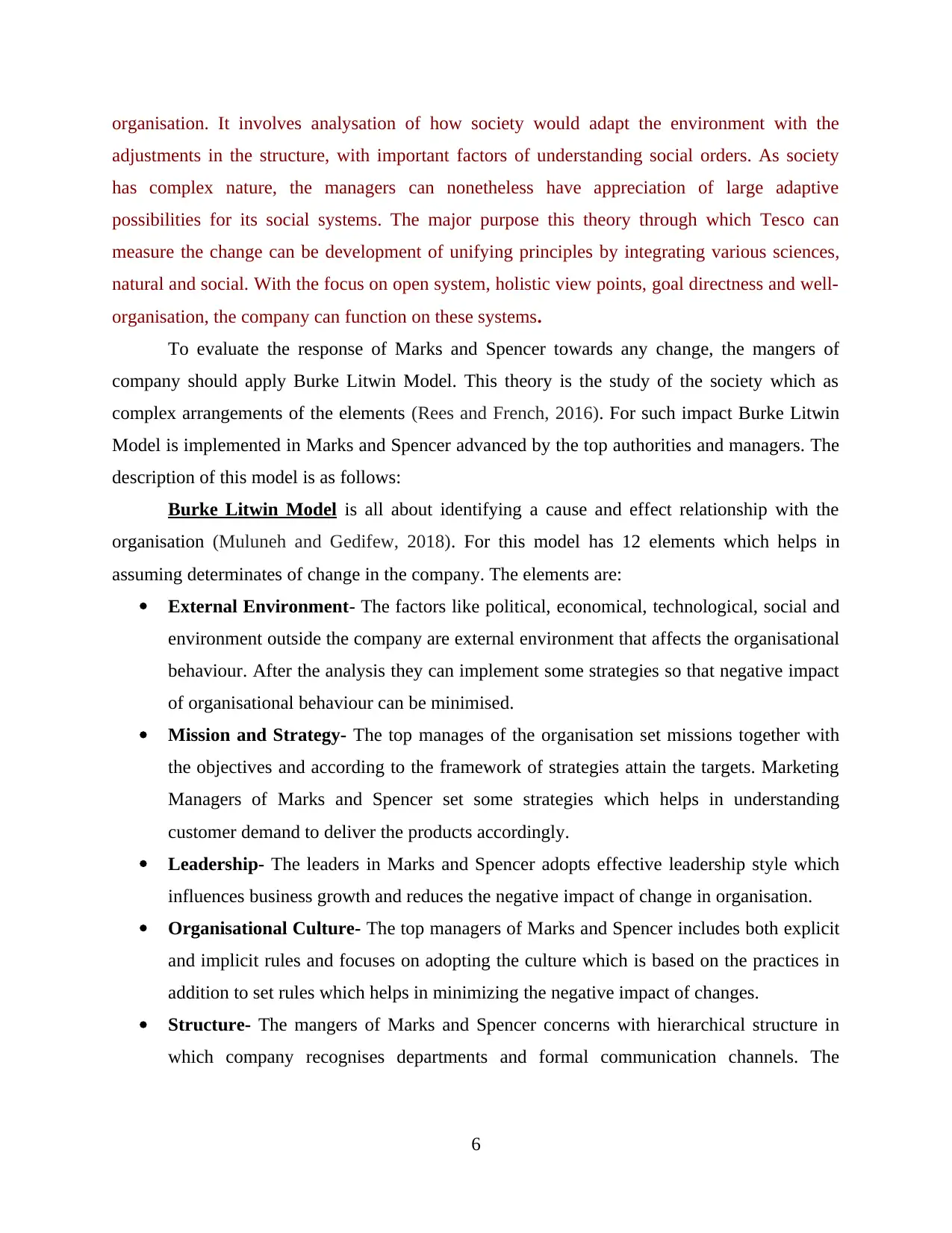
organisation. It involves analysation of how society would adapt the environment with the
adjustments in the structure, with important factors of understanding social orders. As society
has complex nature, the managers can nonetheless have appreciation of large adaptive
possibilities for its social systems. The major purpose this theory through which Tesco can
measure the change can be development of unifying principles by integrating various sciences,
natural and social. With the focus on open system, holistic view points, goal directness and well-
organisation, the company can function on these systems.
To evaluate the response of Marks and Spencer towards any change, the mangers of
company should apply Burke Litwin Model. This theory is the study of the society which as
complex arrangements of the elements (Rees and French, 2016). For such impact Burke Litwin
Model is implemented in Marks and Spencer advanced by the top authorities and managers. The
description of this model is as follows:
Burke Litwin Model is all about identifying a cause and effect relationship with the
organisation (Muluneh and Gedifew, 2018). For this model has 12 elements which helps in
assuming determinates of change in the company. The elements are:
External Environment- The factors like political, economical, technological, social and
environment outside the company are external environment that affects the organisational
behaviour. After the analysis they can implement some strategies so that negative impact
of organisational behaviour can be minimised.
Mission and Strategy- The top manages of the organisation set missions together with
the objectives and according to the framework of strategies attain the targets. Marketing
Managers of Marks and Spencer set some strategies which helps in understanding
customer demand to deliver the products accordingly.
Leadership- The leaders in Marks and Spencer adopts effective leadership style which
influences business growth and reduces the negative impact of change in organisation.
Organisational Culture- The top managers of Marks and Spencer includes both explicit
and implicit rules and focuses on adopting the culture which is based on the practices in
addition to set rules which helps in minimizing the negative impact of changes.
Structure- The mangers of Marks and Spencer concerns with hierarchical structure in
which company recognises departments and formal communication channels. The
6
adjustments in the structure, with important factors of understanding social orders. As society
has complex nature, the managers can nonetheless have appreciation of large adaptive
possibilities for its social systems. The major purpose this theory through which Tesco can
measure the change can be development of unifying principles by integrating various sciences,
natural and social. With the focus on open system, holistic view points, goal directness and well-
organisation, the company can function on these systems.
To evaluate the response of Marks and Spencer towards any change, the mangers of
company should apply Burke Litwin Model. This theory is the study of the society which as
complex arrangements of the elements (Rees and French, 2016). For such impact Burke Litwin
Model is implemented in Marks and Spencer advanced by the top authorities and managers. The
description of this model is as follows:
Burke Litwin Model is all about identifying a cause and effect relationship with the
organisation (Muluneh and Gedifew, 2018). For this model has 12 elements which helps in
assuming determinates of change in the company. The elements are:
External Environment- The factors like political, economical, technological, social and
environment outside the company are external environment that affects the organisational
behaviour. After the analysis they can implement some strategies so that negative impact
of organisational behaviour can be minimised.
Mission and Strategy- The top manages of the organisation set missions together with
the objectives and according to the framework of strategies attain the targets. Marketing
Managers of Marks and Spencer set some strategies which helps in understanding
customer demand to deliver the products accordingly.
Leadership- The leaders in Marks and Spencer adopts effective leadership style which
influences business growth and reduces the negative impact of change in organisation.
Organisational Culture- The top managers of Marks and Spencer includes both explicit
and implicit rules and focuses on adopting the culture which is based on the practices in
addition to set rules which helps in minimizing the negative impact of changes.
Structure- The mangers of Marks and Spencer concerns with hierarchical structure in
which company recognises departments and formal communication channels. The
6
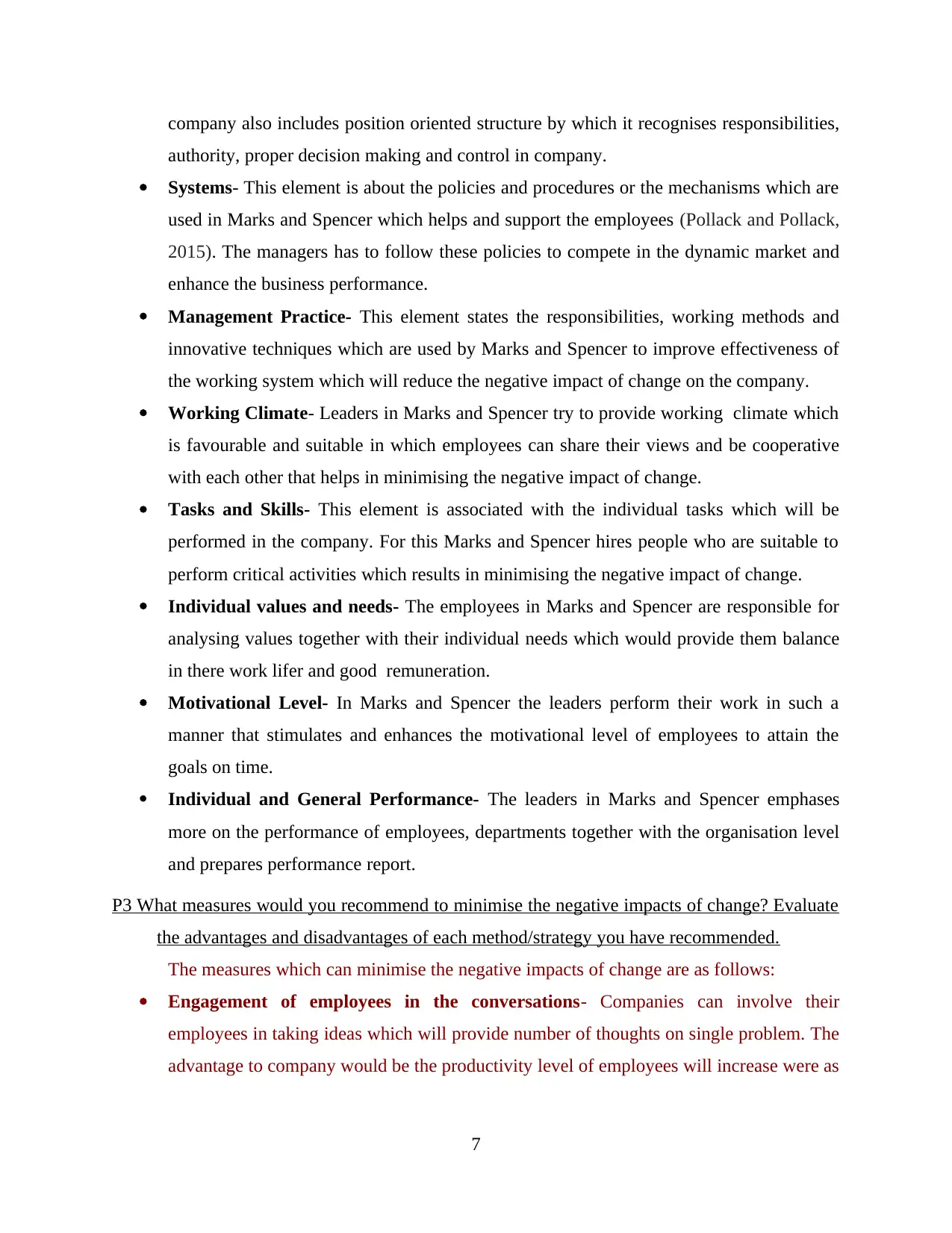
company also includes position oriented structure by which it recognises responsibilities,
authority, proper decision making and control in company.
Systems- This element is about the policies and procedures or the mechanisms which are
used in Marks and Spencer which helps and support the employees (Pollack and Pollack,
2015). The managers has to follow these policies to compete in the dynamic market and
enhance the business performance.
Management Practice- This element states the responsibilities, working methods and
innovative techniques which are used by Marks and Spencer to improve effectiveness of
the working system which will reduce the negative impact of change on the company.
Working Climate- Leaders in Marks and Spencer try to provide working climate which
is favourable and suitable in which employees can share their views and be cooperative
with each other that helps in minimising the negative impact of change.
Tasks and Skills- This element is associated with the individual tasks which will be
performed in the company. For this Marks and Spencer hires people who are suitable to
perform critical activities which results in minimising the negative impact of change.
Individual values and needs- The employees in Marks and Spencer are responsible for
analysing values together with their individual needs which would provide them balance
in there work lifer and good remuneration.
Motivational Level- In Marks and Spencer the leaders perform their work in such a
manner that stimulates and enhances the motivational level of employees to attain the
goals on time.
Individual and General Performance- The leaders in Marks and Spencer emphases
more on the performance of employees, departments together with the organisation level
and prepares performance report.
P3 What measures would you recommend to minimise the negative impacts of change? Evaluate
the advantages and disadvantages of each method/strategy you have recommended.
The measures which can minimise the negative impacts of change are as follows:
Engagement of employees in the conversations- Companies can involve their
employees in taking ideas which will provide number of thoughts on single problem. The
advantage to company would be the productivity level of employees will increase were as
7
authority, proper decision making and control in company.
Systems- This element is about the policies and procedures or the mechanisms which are
used in Marks and Spencer which helps and support the employees (Pollack and Pollack,
2015). The managers has to follow these policies to compete in the dynamic market and
enhance the business performance.
Management Practice- This element states the responsibilities, working methods and
innovative techniques which are used by Marks and Spencer to improve effectiveness of
the working system which will reduce the negative impact of change on the company.
Working Climate- Leaders in Marks and Spencer try to provide working climate which
is favourable and suitable in which employees can share their views and be cooperative
with each other that helps in minimising the negative impact of change.
Tasks and Skills- This element is associated with the individual tasks which will be
performed in the company. For this Marks and Spencer hires people who are suitable to
perform critical activities which results in minimising the negative impact of change.
Individual values and needs- The employees in Marks and Spencer are responsible for
analysing values together with their individual needs which would provide them balance
in there work lifer and good remuneration.
Motivational Level- In Marks and Spencer the leaders perform their work in such a
manner that stimulates and enhances the motivational level of employees to attain the
goals on time.
Individual and General Performance- The leaders in Marks and Spencer emphases
more on the performance of employees, departments together with the organisation level
and prepares performance report.
P3 What measures would you recommend to minimise the negative impacts of change? Evaluate
the advantages and disadvantages of each method/strategy you have recommended.
The measures which can minimise the negative impacts of change are as follows:
Engagement of employees in the conversations- Companies can involve their
employees in taking ideas which will provide number of thoughts on single problem. The
advantage to company would be the productivity level of employees will increase were as
7
⊘ This is a preview!⊘
Do you want full access?
Subscribe today to unlock all pages.

Trusted by 1+ million students worldwide
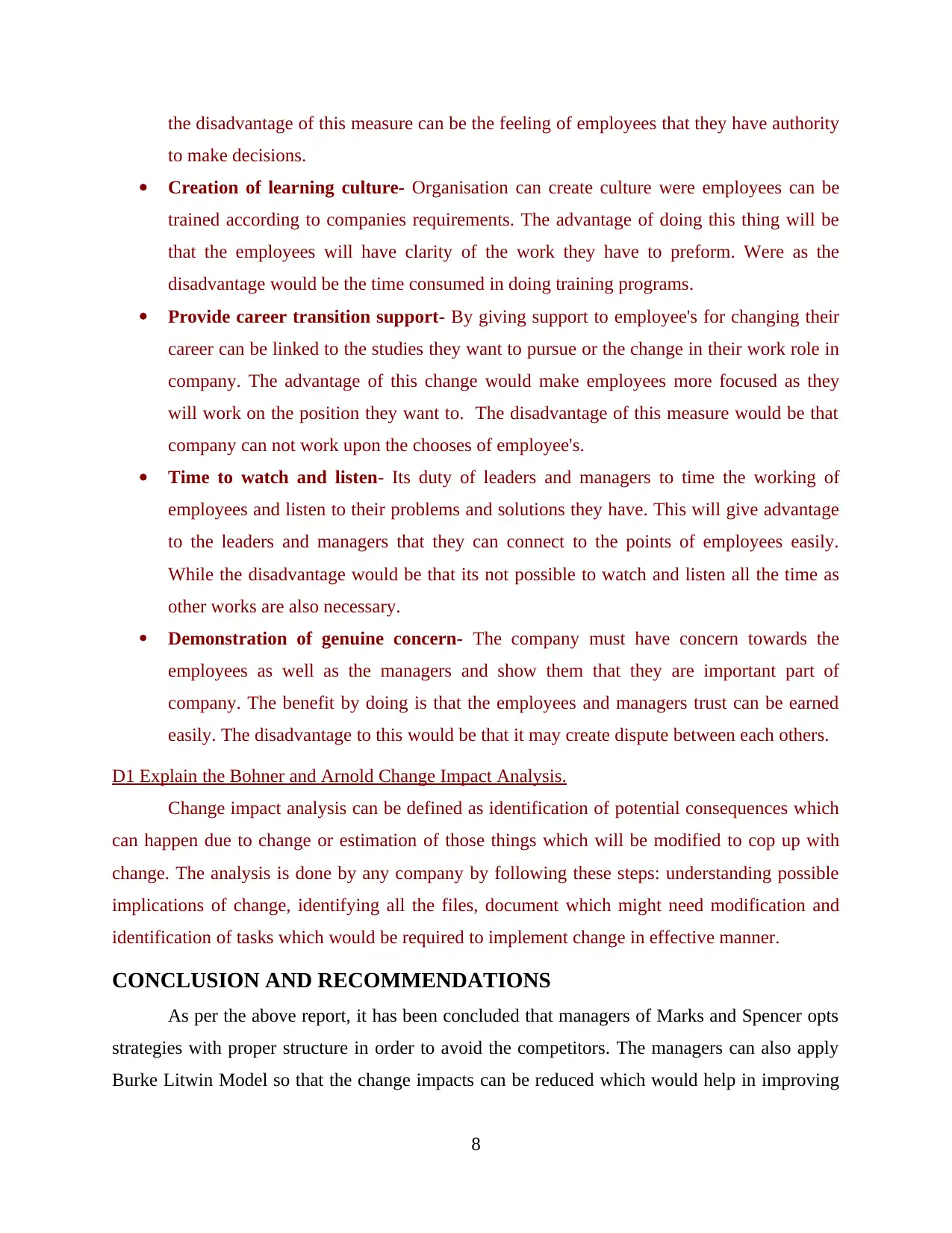
the disadvantage of this measure can be the feeling of employees that they have authority
to make decisions.
Creation of learning culture- Organisation can create culture were employees can be
trained according to companies requirements. The advantage of doing this thing will be
that the employees will have clarity of the work they have to preform. Were as the
disadvantage would be the time consumed in doing training programs.
Provide career transition support- By giving support to employee's for changing their
career can be linked to the studies they want to pursue or the change in their work role in
company. The advantage of this change would make employees more focused as they
will work on the position they want to. The disadvantage of this measure would be that
company can not work upon the chooses of employee's.
Time to watch and listen- Its duty of leaders and managers to time the working of
employees and listen to their problems and solutions they have. This will give advantage
to the leaders and managers that they can connect to the points of employees easily.
While the disadvantage would be that its not possible to watch and listen all the time as
other works are also necessary.
Demonstration of genuine concern- The company must have concern towards the
employees as well as the managers and show them that they are important part of
company. The benefit by doing is that the employees and managers trust can be earned
easily. The disadvantage to this would be that it may create dispute between each others.
D1 Explain the Bohner and Arnold Change Impact Analysis.
Change impact analysis can be defined as identification of potential consequences which
can happen due to change or estimation of those things which will be modified to cop up with
change. The analysis is done by any company by following these steps: understanding possible
implications of change, identifying all the files, document which might need modification and
identification of tasks which would be required to implement change in effective manner.
CONCLUSION AND RECOMMENDATIONS
As per the above report, it has been concluded that managers of Marks and Spencer opts
strategies with proper structure in order to avoid the competitors. The managers can also apply
Burke Litwin Model so that the change impacts can be reduced which would help in improving
8
to make decisions.
Creation of learning culture- Organisation can create culture were employees can be
trained according to companies requirements. The advantage of doing this thing will be
that the employees will have clarity of the work they have to preform. Were as the
disadvantage would be the time consumed in doing training programs.
Provide career transition support- By giving support to employee's for changing their
career can be linked to the studies they want to pursue or the change in their work role in
company. The advantage of this change would make employees more focused as they
will work on the position they want to. The disadvantage of this measure would be that
company can not work upon the chooses of employee's.
Time to watch and listen- Its duty of leaders and managers to time the working of
employees and listen to their problems and solutions they have. This will give advantage
to the leaders and managers that they can connect to the points of employees easily.
While the disadvantage would be that its not possible to watch and listen all the time as
other works are also necessary.
Demonstration of genuine concern- The company must have concern towards the
employees as well as the managers and show them that they are important part of
company. The benefit by doing is that the employees and managers trust can be earned
easily. The disadvantage to this would be that it may create dispute between each others.
D1 Explain the Bohner and Arnold Change Impact Analysis.
Change impact analysis can be defined as identification of potential consequences which
can happen due to change or estimation of those things which will be modified to cop up with
change. The analysis is done by any company by following these steps: understanding possible
implications of change, identifying all the files, document which might need modification and
identification of tasks which would be required to implement change in effective manner.
CONCLUSION AND RECOMMENDATIONS
As per the above report, it has been concluded that managers of Marks and Spencer opts
strategies with proper structure in order to avoid the competitors. The managers can also apply
Burke Litwin Model so that the change impacts can be reduced which would help in improving
8
Paraphrase This Document
Need a fresh take? Get an instant paraphrase of this document with our AI Paraphraser
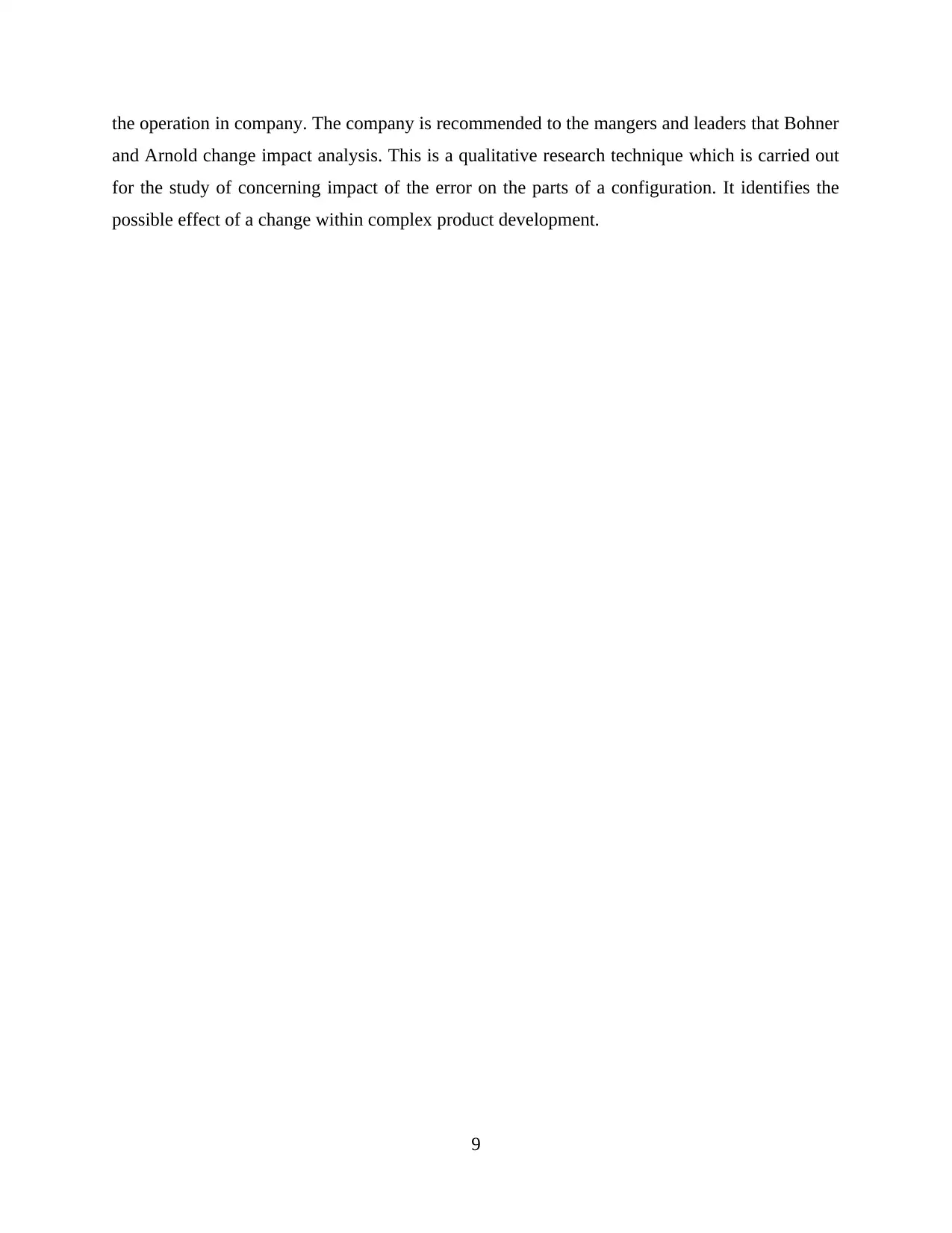
the operation in company. The company is recommended to the mangers and leaders that Bohner
and Arnold change impact analysis. This is a qualitative research technique which is carried out
for the study of concerning impact of the error on the parts of a configuration. It identifies the
possible effect of a change within complex product development.
9
and Arnold change impact analysis. This is a qualitative research technique which is carried out
for the study of concerning impact of the error on the parts of a configuration. It identifies the
possible effect of a change within complex product development.
9
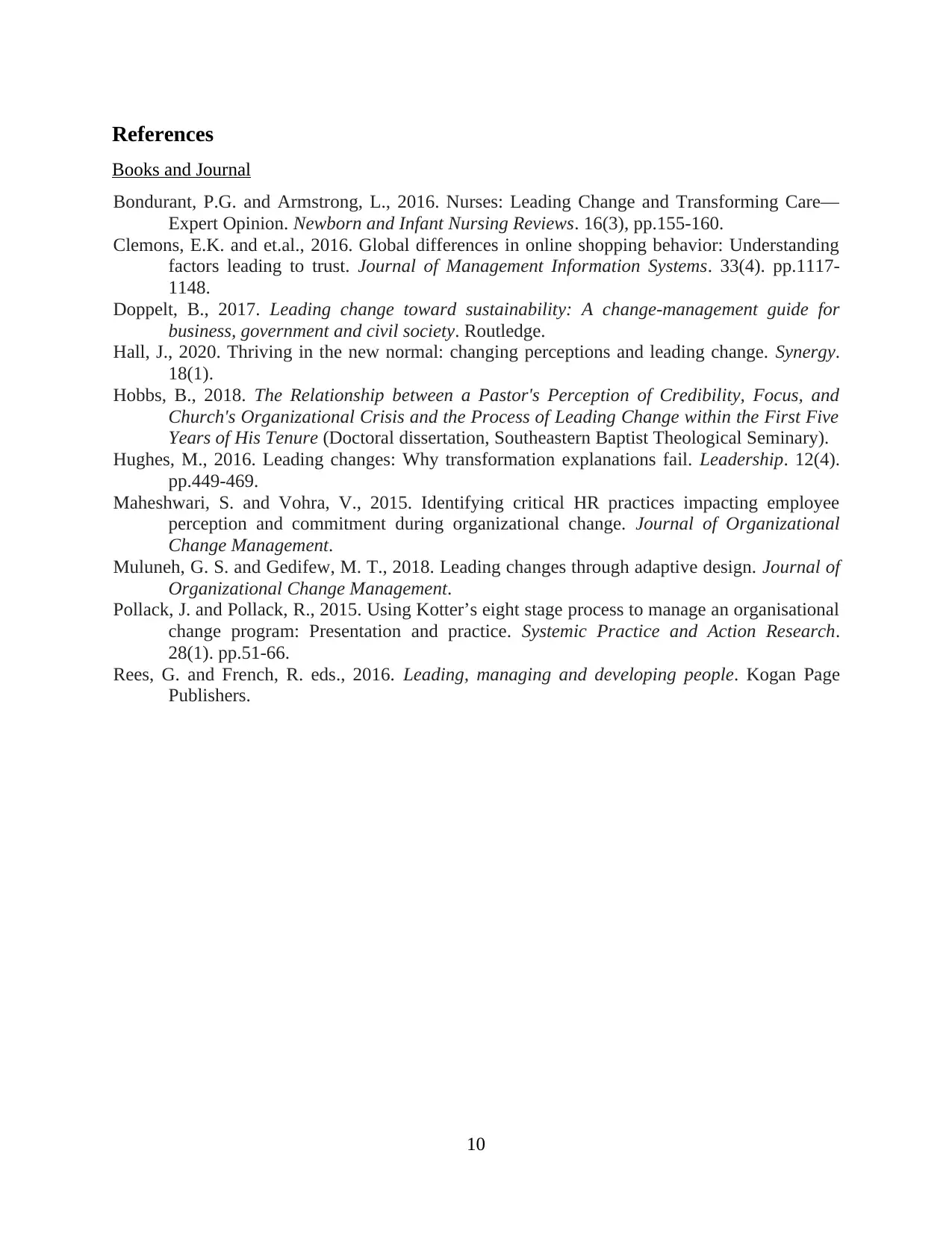
References
Books and Journal
Bondurant, P.G. and Armstrong, L., 2016. Nurses: Leading Change and Transforming Care—
Expert Opinion. Newborn and Infant Nursing Reviews. 16(3), pp.155-160.
Clemons, E.K. and et.al., 2016. Global differences in online shopping behavior: Understanding
factors leading to trust. Journal of Management Information Systems. 33(4). pp.1117-
1148.
Doppelt, B., 2017. Leading change toward sustainability: A change-management guide for
business, government and civil society. Routledge.
Hall, J., 2020. Thriving in the new normal: changing perceptions and leading change. Synergy.
18(1).
Hobbs, B., 2018. The Relationship between a Pastor's Perception of Credibility, Focus, and
Church's Organizational Crisis and the Process of Leading Change within the First Five
Years of His Tenure (Doctoral dissertation, Southeastern Baptist Theological Seminary).
Hughes, M., 2016. Leading changes: Why transformation explanations fail. Leadership. 12(4).
pp.449-469.
Maheshwari, S. and Vohra, V., 2015. Identifying critical HR practices impacting employee
perception and commitment during organizational change. Journal of Organizational
Change Management.
Muluneh, G. S. and Gedifew, M. T., 2018. Leading changes through adaptive design. Journal of
Organizational Change Management.
Pollack, J. and Pollack, R., 2015. Using Kotter’s eight stage process to manage an organisational
change program: Presentation and practice. Systemic Practice and Action Research.
28(1). pp.51-66.
Rees, G. and French, R. eds., 2016. Leading, managing and developing people. Kogan Page
Publishers.
10
Books and Journal
Bondurant, P.G. and Armstrong, L., 2016. Nurses: Leading Change and Transforming Care—
Expert Opinion. Newborn and Infant Nursing Reviews. 16(3), pp.155-160.
Clemons, E.K. and et.al., 2016. Global differences in online shopping behavior: Understanding
factors leading to trust. Journal of Management Information Systems. 33(4). pp.1117-
1148.
Doppelt, B., 2017. Leading change toward sustainability: A change-management guide for
business, government and civil society. Routledge.
Hall, J., 2020. Thriving in the new normal: changing perceptions and leading change. Synergy.
18(1).
Hobbs, B., 2018. The Relationship between a Pastor's Perception of Credibility, Focus, and
Church's Organizational Crisis and the Process of Leading Change within the First Five
Years of His Tenure (Doctoral dissertation, Southeastern Baptist Theological Seminary).
Hughes, M., 2016. Leading changes: Why transformation explanations fail. Leadership. 12(4).
pp.449-469.
Maheshwari, S. and Vohra, V., 2015. Identifying critical HR practices impacting employee
perception and commitment during organizational change. Journal of Organizational
Change Management.
Muluneh, G. S. and Gedifew, M. T., 2018. Leading changes through adaptive design. Journal of
Organizational Change Management.
Pollack, J. and Pollack, R., 2015. Using Kotter’s eight stage process to manage an organisational
change program: Presentation and practice. Systemic Practice and Action Research.
28(1). pp.51-66.
Rees, G. and French, R. eds., 2016. Leading, managing and developing people. Kogan Page
Publishers.
10
⊘ This is a preview!⊘
Do you want full access?
Subscribe today to unlock all pages.

Trusted by 1+ million students worldwide
1 out of 12
Related Documents
Your All-in-One AI-Powered Toolkit for Academic Success.
+13062052269
info@desklib.com
Available 24*7 on WhatsApp / Email
![[object Object]](/_next/static/media/star-bottom.7253800d.svg)
Unlock your academic potential
Copyright © 2020–2025 A2Z Services. All Rights Reserved. Developed and managed by ZUCOL.





